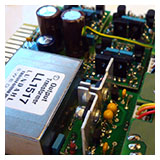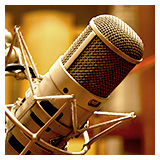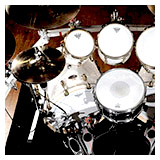 | US$900 | €795 | £695 |
| US$900 | €795 | £695 |


As with the other 500 Series modules in this range, the Tonic signal path uses our True Class A BE41 amplifiers followed by a BE50 buffer to excite the Lundahl output transformer. The resulting sound is big and open with a nice touch of transformer color. The design allows for +26dB headroom so major boosts at low frequencies are not a problem with the Tonic - it always sounds huge!
The Tonic utilizes real inductors (chokes) in the high and low bands whilst the sweepable mid band features an active filter based on the Constant Amplitude Phase Shift circuit proposed my Mr Steve Dove in 1981. The combination of the old passive circuits with a modern active design gives you the best of both worlds. The chokes in the bass and treble provide the smooth sound of real resonance in addition to the versatility of the sweep mid band.

![]() Other 500 series modules - | Essence opto compressor | Elixir mic preamp |
Other 500 series modules - | Essence opto compressor | Elixir mic preamp |
![]() The low band and high band have centre detent pots for +/-15dB of boost/cut range. Toggle switches select bell or shelf mode on these two bands. The low band turnover frequency can be selected to 60Hz or 120Hz and the high band 5kHz or 11kHz.
The low band and high band have centre detent pots for +/-15dB of boost/cut range. Toggle switches select bell or shelf mode on these two bands. The low band turnover frequency can be selected to 60Hz or 120Hz and the high band 5kHz or 11kHz.
![]() The mid band frequency can cover the range of 75Hz to 11.5kHz via the x1/x10 range switch. Another switch selects wide or narrow bandwidth (Q), and a centre detent pot sets the mid band +/-15db boost/cut range.
The mid band frequency can cover the range of 75Hz to 11.5kHz via the x1/x10 range switch. Another switch selects wide or narrow bandwidth (Q), and a centre detent pot sets the mid band +/-15db boost/cut range.
![]() Additional toggles are provided to Bypass the module and to switch in the High Pass Filter. The high pass filter turnover frequency can be set by the user to 85Hz or 50Hz via jumpers on the circuit board. A Peak led lights up when the output level reaches +22dBu.
Additional toggles are provided to Bypass the module and to switch in the High Pass Filter. The high pass filter turnover frequency can be set by the user to 85Hz or 50Hz via jumpers on the circuit board. A Peak led lights up when the output level reaches +22dBu.
 I finally tested the Buzz Tonic. And I also tested it against an 1073 clone. And I must say that the Buzz Tonic blew my mind. As I told you I was looking for a 1073 style eq but the Tonic brings that punch but also so much more liveliness than the classic 1073 design. I decided to buy the Tonic. It really is something else. I also have the impression that the high pass filter works more efficiently than a software high pass filter. I mean in general the sound is absolutely superior to any software out there but I always thought that an high pass filter alone in hardware vs software doesn‘t make a difference. But here I feel that it cleans vocals way better than software high pass filters even if I push 120 hz (which sounds amazing btw). Also the mid band really grabs the signal and gives it amazing heft when boosting. How did you do that without an inductor? However, amazing eq. And even tough it is marketed as non-colored I feel it brings liveliness to the signal by itself.
I finally tested the Buzz Tonic. And I also tested it against an 1073 clone. And I must say that the Buzz Tonic blew my mind. As I told you I was looking for a 1073 style eq but the Tonic brings that punch but also so much more liveliness than the classic 1073 design. I decided to buy the Tonic. It really is something else. I also have the impression that the high pass filter works more efficiently than a software high pass filter. I mean in general the sound is absolutely superior to any software out there but I always thought that an high pass filter alone in hardware vs software doesn‘t make a difference. But here I feel that it cleans vocals way better than software high pass filters even if I push 120 hz (which sounds amazing btw). Also the mid band really grabs the signal and gives it amazing heft when boosting. How did you do that without an inductor? However, amazing eq. And even tough it is marketed as non-colored I feel it brings liveliness to the signal by itself.
Maximum Input Level; +23dBu
Maximum Output Level; +26dBu into 3k ohm load
Frequency Response EQ set flat; 17Hz to 175kHz (+1dB, -3dB)
Harmonic Distortion measured +10dBu output level; 0.08% @ 100Hz, 0.02% @ 1kHz, 0.005% @ 10kHz
Signal to Noise Ratio; -88dB A wtg, input shorted
Input Impedance; 20k ohms approx balanced
Indicators; Single LED overload indicator
Size; (37Wx132H). Fits 1 space in API* 500 series rack format
Power requirements; 120mA +/- 15-18 volts DC, as supplied by frame power supply.
Specifications are typical of a production unit and are subject to change without notice. 0dBu reference = 0.775 volts RMS
Buzz Audio Ltd
Blenheim
New Zealand
Ph +64(0)3-577-5597
send us an email
